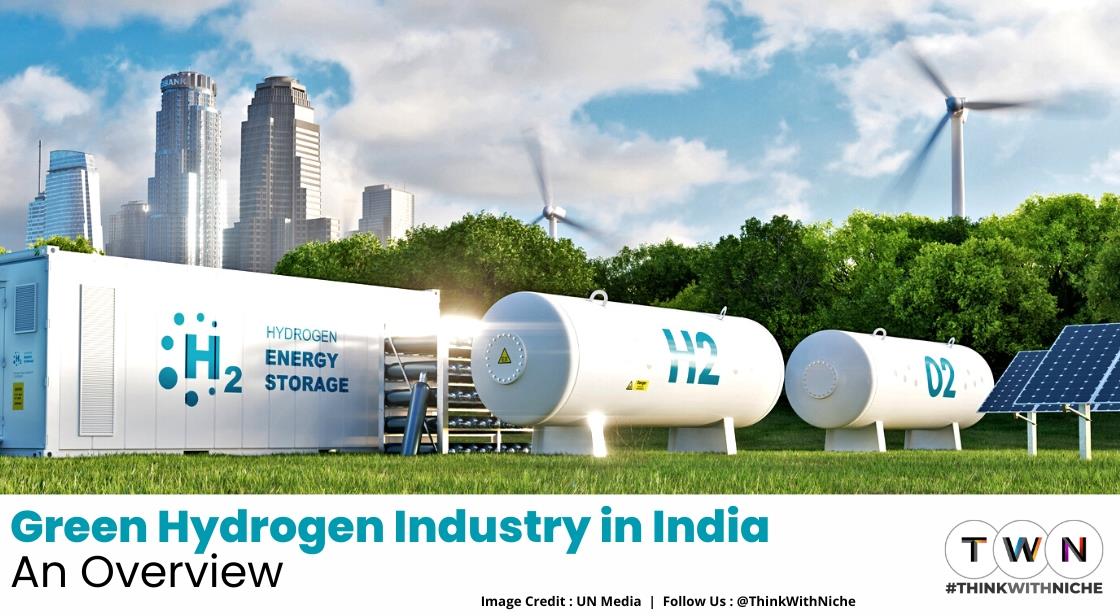Green Hydrogen Industry In India: An Overview

Blog Post
Decarbonizing the earth is one of the world's top priorities right now, and 2050 has been set as the target year. Since hydrogen production accounts for more than 2% of the world's carbon emissions, decarbonizing it would be one of the most significant steps to be made in this regard. Green hydrogen enters the picture at this point.
India's strong commitment to aspirational climate goals has received widespread recognition in international relations. Our goals have been met by our achievements. The capacity of renewable energy is expanding the fastest in India.
India has also become one of the most attractive locations for renewable energy investments. We acknowledge the crucial significance of Green Hydrogen as India has set its aims on achieving Net Zero by 2070 and energy independence by 2047.
India has the potential to supply the rest of the globe with green hydrogen because to its vast renewable energy resources. The National Green Hydrogen Mission's goal is to offer a thorough action plan for creating a green hydrogen ecosystem and igniting a systemic reaction to the opportunities and difficulties of this emerging industry.
Given the aforementioned facts, it is essential to understand various facets of India's Green Hydrogen Industry. Therefore, we will provide an overview of the green hydrogen industry in India in this article.
Within the next 30 years, India aims to decarbonize. The government of India has made deliberate decisions to cut back on expensive imports and reduce its dependency on fossil fuels. The goal of our nation to reach 175 GW of renewable energy capacity by 2022 has been significantly boosted by new policies. India is currently concentrating on the research and production of green hydrogen as an energy source as part of these efforts.
This article will explore the green hydrogen energy industry, which is rapidly developing and essential to India's expanding economy. We'll also discover who the leading players in this space are.
Green Hydrogen Industry In India: An Overview
What is Green Hydrogen, exactly?
The most prevalent element in the universe is hydrogen. It only exists, though, when combined with other elements. It is common practice to extract hydrogen from components like water, and the procedure can be highly energy-intensive. Three categories can be made for hydrogen depending on where it comes from and how it gets there:
- Grey hydrogen is produced from fossil fuels, (primarily natural gas).
- Blue hydrogen is produced from fossil fuels and has possibilities for carbon capture and storage.
- Green hydrogen, produced by sustainable energy sources including solar, wind, and geothermal energy, is the last type.
Water is split into hydrogen and oxygen using renewable electricity to create green hydrogen. The term "electrolysis" refers to this chemical process. The fact that green hydrogen burns cleanly is its greatest benefit. In the iron and steel, chemical, and transportation sectors, it can aid in lowering carbon emissions. Indeed, a genuinely groundbreaking idea!
India's Green Hydrogen Industry
Green hydrogen is presently seen as the best way to reach net-zero emissions because it is one of the cleanest sources of energy. Currently, a number of nations are pouring billions of dollars into the construction of green hydrogen infrastructure. India has also made a number of actions to assist environmental causes.
Prime Minister Narendra Modi proclaimed his intention to make in India a centre for the production and export of green hydrogen when he introduced the National Hydrogen Energy Mission (NHEM) in August 2021. The government would invest Rs 800 crore between 2021 and 2024 in projects that seek to lower the cost of producing green hydrogen.
Currently, India spends more than Rs 12 lakh crore annually on energy imports. In the near future, there will likely be a 2-3 fold increase in our reliance on coal and oil. As a result, NHEM will assist in reducing our dependency on costly oil imports. In the long run, green hydrogen will be required to meet energy consumption demands.
The Green Hydrogen Policy was launched by the Indian government in February 2022. By 2030, it seeks to produce 5 million metric tonnes per year (MTPA) of green hydrogen. According to this policy, a renewable energy plant built to provide electricity for the generation of green hydrogen before July 2025 will receive 25 years of free power transmission! This policy will increase the sense of competition among participants in the green hydrogen market.
The development of hydrogen fuel cell technology for use in vehicles is being pursued by various organisations. Many hydrogen-powered automobiles will soon be cruising Indian highways!
Green hydrogen's benefits
- A completely sustainable source is hydrogen: When green hydrogen is produced or burned, no harmful gases are released.
- Since green hydrogen is a gas, it may be kept in storage with ease. Immediately after its creation, it can be used for other purposes.
- It is easily converted into synthetic gas or electricity, which can subsequently be used for industrial, commercial, and domestic needs.
- Natural gas can be blended with green hydrogen up to a maximum of 20%. It can also be carried out using the same infrastructure and pipes.
Let's now examine the top 5 businesses driving India's green hydrogen boom.
Top 3 Indian Companies Leading India's green hydrogen boom
1. Reliance Industries Ltd
With very ambitious goals, Reliance Industries Ltd. (RIL) has entered the green energy market. Over the next three years, Chairman Mukesh Ambani will invest $10 billion (or Rs 75,400 crore) on solar, green hydrogen, batteries, and fuel cells.
The Dhirubhai Ambani Green Energy Giga Complex in Jamnagar, Gujarat, is also being built by RIL. This Rs 60,000 crore project would create an integrated factory that produces parts for fuel cells, batteries, solar cells, and modules, as well as an electrolyzer plant that generates green hydrogen.
To develop and produce hydrogen electrolyzers, RIL has teamed with the Danish company Stiesdal A/S through its subsidiary Reliance New Energy Solar Ltd.
By 2030, Reliance promises to manufacture green hydrogen at a cost of $1 per kilogramme.
2. GAIL India Limited
To support its natural gas business with carbon-free fuel, GAIL is now building the largest green hydrogen plant in our nation. To buy an electrolyzer that can produce 4.5 tonnes of hydrogen per day, it just put out a global tender. As part of a pilot project, the business has also begun incorporating hydrogen into the natural gas pipelines of significant cities.
3. NTPC
The state-owned National Thermal Power Corporation Limited. NTPC intends to commercially create green hydrogen. In Rann of Kutch, NTPC plans to build a 4,750 MW renewable energy facility. At one of its facilities in Uttar Pradesh, where the price of hydrogen is currently between $2.8 and $3 a kilogramme, the company is operating a pilot project.
In Leh, Ladakh, NTPC also intends to build its first green hydrogen refuelling station. By 2032, the PSU wants to have 60 GW of renewable energy capacity.
4. Indian Oil Corporation (IOC)
At its Mathura refinery in Uttar Pradesh, Indian Oil Corporation (IOC) IOC wants to establish a green hydrogen plant. The facility's daily capacity is predicted to be close to 1.6 lakh barrels. The corporation has set a goal to switch at least 10% of the hydrogen used at refineries in the coming years to green hydrogen.
In Kochi, Kerala, IOC also plans to build a stand-alone green hydrogen production facility. Cochin International Airport Ltd.'s solar power facility will be used to power this device.
5. Larsen & Toubro
A significant agreement was signed by Larsen & Toubro and HydrogenPro AS of Norway to set up an alkaline water electrolysis facility in India. In addition, they want to build green hydrogen plants at their production facilities.
In order to establish a green hydrogen business in India, L&T recently announced the creation of a joint venture with Indian Oil Corporation and the Nasdaq-listed ReNew Power.
By the year 2040, L&T wants to be a net-zero enterprise. In the upcoming years, the corporation plans to spend between Rs 1,000 and Rs 5,000 crore on green initiatives.
Conclusion
The green hydrogen market in India is still in its infancy. The electrolyser is the most expensive component of the process of producing hydrogen fuel. Moving or transporting hydrogen is also highly expensive. A larger manufacturing footprint could lower these expenses. However, poor demand has resulted in low manufacturing capacities.
Despite these difficulties, our government has started to support green hydrogen research and development. The Indian hydrogen market was worth $50 million in 2017. By 2025, this market is anticipated to reach $81 million! It seems sensible that many businesses are investing in this incredibly promising industry.
They have already begun to take advantage of hydrogen's potential as an energy source. Many are looking into ways to lower production costs and identify other use cases. As citizens, we can raise knowledge of green hydrogen technology and its environmental advantages.
You May Like
EDITOR’S CHOICE












